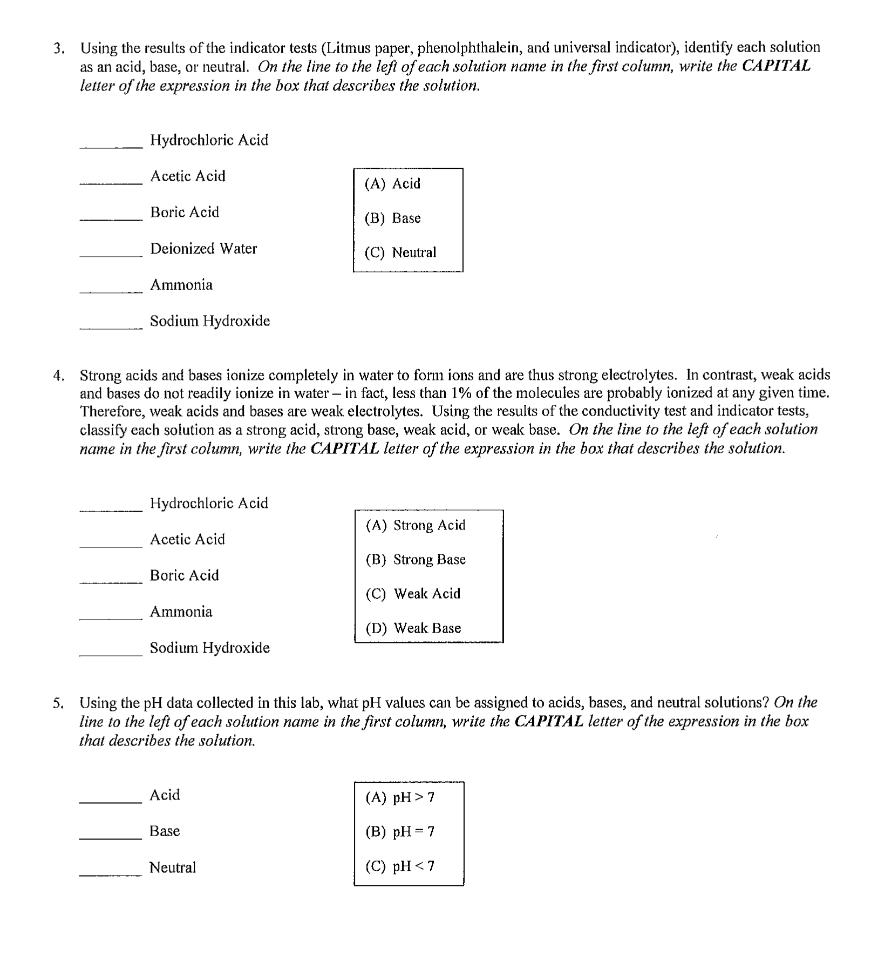Answered step by step
Verified Expert Solution
Question
1 Approved Answer
1. Using the results of the conductivity test, identify each solution as a strong electrolyte, weak electrolyte or nonelectrolyte. On the line to the


1. Using the results of the conductivity test, identify each solution as a strong electrolyte, weak electrolyte or nonelectrolyte. On the line to the left of each solution name in the first column, write the CAPITAL letter of the expression in the box that describes the solution. Hydrochloric Acid Acetic Acid (A) Strong Electrolyte Boric Acid (B) Weak Electrolyte Deionized Water (C) Non-electrolyte Ammonia Sodium Hydroxide 2. Hydrochloric acid, acetic acid, and boric acid all react with magnesium metal to produce hydrogen gas. Write a chemical equation for each solution that reacted with magnesium metal. Hint: These are single replacement reactions. 3. Using the results of the indicator tests (Litmus paper, phenolphthalein, and universal indicator), identify each solution as an acid, base, or neutral. On the line to the left of each solution name in the first column, write the CAPITAL letter of the expression in the box that describes the solution. Hydrochloric Acid Acetic Acid (A) Acid Boric Acid (B) Base Deionized Water (C) Neutral Ammonia Sodium Hydroxide 4. Strong acids and bases ionize completely in water to form ions and are thus strong electrolytes. In contrast, weak acids and bases do not readily ionize in water - in fact, less than 1% of the molecules are probably ionized at any given time. Therefore, weak acids and bases are weak electrolytes. Using the results of the conductivity test and indicator tests, classify each solution as a strong acid, strong base, weak acid, or weak base. On the line to the left of each solution name in the first column, write the CAPITAL letter of the expression in the box that describes the solution. Hydrochloric Acid Acetic Acid (A) Strong Acid Boric Acid Ammonia (B) Strong Base (C) Weak Acid (D) Weak Base Sodium Hydroxide 5. Using the pH data collected in this lab, what pH values can be assigned to acids, bases, and neutral solutions? On the line to the left of each solution name in the first column, write the CAPITAL letter of the expression in the box that describes the solution. Acid Base (A) pH > 7 (B) pH-7 Neutral (C) pH
Step by Step Solution
There are 3 Steps involved in it
Step: 1

Get Instant Access to Expert-Tailored Solutions
See step-by-step solutions with expert insights and AI powered tools for academic success
Step: 2

Step: 3

Ace Your Homework with AI
Get the answers you need in no time with our AI-driven, step-by-step assistance
Get Started


